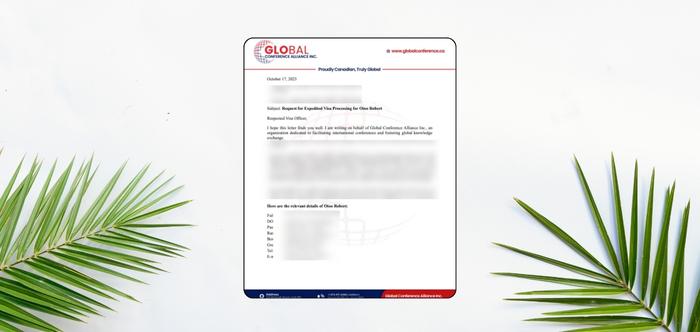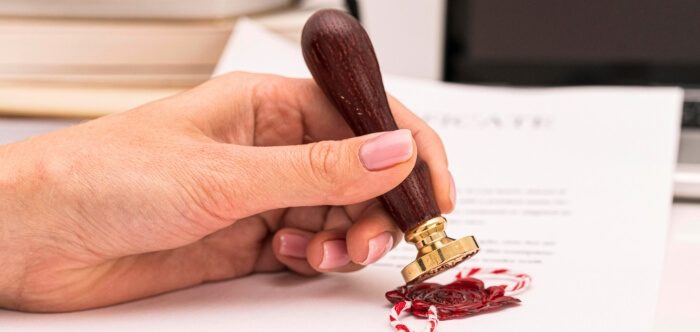Ensuring the legality and authenticity of your documents is crucial, especially when inviting someone to the US. The process may seem daunting, but worry not! If you’ve ever wondered “How to Notarize a Letter of Invitation in USA?”, you’re in the right place.
You can start by drafting an accurate letter. Next, seek out a notary public available at places like banks, libraries, or even county clerk’s offices. Remember to bring along a valid ID, and importantly, sign the letter only when the notary is watching. Upon signing, the notary will then carry out their verification, signing, and stamping.
Intrigued about the details? Dive into this blog to explore the complete process and ensure your invitation is in perfect order. Let’s embark on this legal journey together.
Notarize a Letter of Invitation in the USA – A Short Overview
Handling legal documents can sometimes be a perplexing task, especially when you want to ensure they’re authenticated correctly. A Letter of Invitation is no exception, particularly when it requires notarization in the USA. Many find themselves needing this process, be it for business, personal, or travel reasons.
Finding a notary public is the first significant step. Various establishments, including banks, libraries, and county clerk’s offices, usually provide this crucial service. Once you’ve identified a notary, ensure you have your identification ready for verification purposes. The right ID guarantees that the process is smooth, without any unnecessary hitches.
Drafting the Letter of Invitation requires precision. Every detail should be accurately captured to avoid complications. When you meet the notary, be prepared to sign the letter in their presence. This action allows the notary to verify, sign, and finally stamp the document, confirming its authenticity and your genuine intent.
Types of Notarized Invitation Letters
Notarized invitation letters serve various purposes across both personal and professional domains. Their primary function is to validate the inviter’s intent. Let’s explore different types of notarized invitation letters and their unique roles.
Business Invitation
Notarized business invites are frequently sent out by businesses. These are for gatherings, meetings, or conferences. It guarantees that the invitation will be formal. This kind of letter frequently contains firm credentials and particulars about the event.
Visa Invitation
For individuals traveling abroad, a visa invitation might be needed. This notarized letter confirms the host’s intent to accommodate the traveler. It’s crucial for some countries’ visa applications. It provides authenticity to the traveler’s stated travel purpose.
Wedding Invitation
In specific scenarios, notarized wedding invitations become necessary. Especially for international guests requiring visas. The notarized letter confirms the event and the inviter’s relationship to the guest. It can facilitate the visa application process for the invitee.
Event Invitation
For large-scale events, organizers might use notarized invites. These can be for inaugurations, ceremonies, or cultural events. Notarization adds a layer of official authenticity. It emphasizes the significance and formality of the occasion.
Property Access Invitation
At times, property owners send notarized letters to grant access. This is common for properties in gated communities or secured areas. The notarized letter serves as proof of the owner’s intent. It ensures smooth entry for the invitee.
Academic Invitation
Educational institutions may use notarized letters for special lectures or seminars. These letters invite experts or dignitaries to their campuses. The notarized document underlines the formal and sincere nature of the invitation. It also provides details about the event and its significance.
Different occasions demand varied types of notarized invitation letters. While the core purpose remains consistent—to authenticate the inviter’s intent—each letter type serves a distinct role, catering to specific situations and requirements.
How to Notarize a Letter of Invitation in USA?
Taking the right steps to authenticate official documents can simplify bureaucratic processes. If you’re wondering “How to Notarize a Letter of Invitation in USA?”, you’re in the right place. Let’s delve into a step-by-step guide to make this process seamless for you.
Step-1. Draft the Letter Carefully
Begin by composing your Letter of Invitation. Ensure that all details, like names, addresses, and purposes, are accurately included. A well-structured letter minimizes potential delays. Remember, precision in content can expedite the notarization process.
Step-2. Locate a Notary Public
The next step involves finding a qualified notary public. You can find them at banks, libraries, or county clerk’s offices. Some private businesses also offer notary services. Choose one that’s convenient and reputable.
Step-3. Assemble Necessary Identification
Before meeting the notary, gather essential identification documents. Typically, a valid government-issued ID like a driver’s license or passport suffices. This ID helps the notary confirm your identity, ensuring a smooth verification process.
Step-4. Schedule an Appointment
It’s prudent to set a specific time to meet with your chosen notary. Some may accept walk-ins, but scheduling guarantees their availability. This step ensures you don’t waste time waiting or encountering potential scheduling conflicts.
Step-5. Sign in the Notary’s Presence
Once you meet the notary, wait to sign your letter until instructed. It’s essential to sign in their direct presence. This action is a key part of the process, allowing the notary to verify the authenticity of your signature.
Step-6. Secure the Notary’s Verification
After witnessing your signature, the notary will then affix their official seal and signature. This step officially notarizes your Letter of Invitation. Once stamped and signed, your letter has been authenticated and carries legal weight.
With these straightforward steps, you’ll navigate the process of notarizing a Letter of Invitation in the USA with ease. Remember, while it might seem a bit formal, it’s all about ensuring authenticity and legal compliance.
The Limitations of Notaries And Notarization
Verifying the legality of papers is greatly aided by notarization, but it’s important to be aware of its limitations. Notaries offer important services, however, there are certain constraints to be aware of:
- Not Legal Validation: Notaries verify signers’ identities, not the document’s content. They don’t assess the legality or truth of the document. Thus, notarization isn’t a stamp of legal approval.
- Limited Jurisdiction: Notaries operate within specific jurisdictions, typically state-defined. A notary from California can’t notarize in Texas. Jurisdictional constraints can cause inconveniences.
- No Legal Advice: Notaries aren’t allowed to give legal advice. Those requiring guidance must consult attorneys. Misunderstanding this can lead to legal missteps.
- Expiration of Commission: Notary commissions aren’t forever. They expire after a set period. An expired commission invalidates notarizations, requiring revalidation.
- Fraud Possibility: Despite precautions, fraudulent notarizations occur. Forged signatures or false IDs can deceive notaries. It emphasizes the need for vigilance.
- Physical Presence Often Needed: Traditionally, signers must be physically present. While online notarizations are growing, many states still demand in-person signings, limiting flexibility.
- Language Barriers: If notaries and signers don’t share a language, communication barriers arise. Misunderstandings can compromise the notarization’s integrity.
- Document Limitations: Not all documents can be notarized. Some require specific legal professionals. It’s essential to understand these distinctions.
- Fee Variability: Notarization fees vary by state and service. Unexpected costs can arise, especially for specialized notarizations, causing financial surprises.
- No Conflict Resolution: Notaries can’t mediate or resolve conflicts between signing parties. Their role is verification, not intervention or mediation in disagreements.
Recognizing these limitations can help individuals approach notarization with informed expectations, ensuring smoother and more predictable experiences.
Tips for Organizing And Storing Notarized Letters Securely
Securing notarized documents is pivotal to safeguarding their authenticity and value. Notarized letters, being legally significant, demand careful organization and storage. Let’s delve into some tips to manage these essential documents efficiently.
Digital Backups
Always scan and create digital copies of notarized letters. Store them in a secure cloud storage or encrypted drive. Digital versions act as backups in case of physical damage. However, remember, digital copies aren’t a substitute for originals.
Fireproof Safes
Invest in a high-quality fireproof safe for originals. These safes protect against unexpected fires, ensuring document safety. Choose a safe with multiple compartments for organization. Ensure it’s both fireproof and waterproof for added security.
Label and Categorize
Categorize notarized letters based on their purpose. Create separate sections for personal, business, and other categories. Label each section clearly to facilitate easy access. Regularly update and declutter to maintain an efficient system.
Restricted Access
Limit access to your stored notarized letters. Designate a trusted individual or two, but avoid general access. Frequent handling increases the risk of damage or misplacement. Keeping access restricted ensures the letters remain pristine.
Climate Control
Store letters in a climate-controlled environment. Humidity can damage paper, causing mold or deterioration. Too much heat can also degrade paper quality. Ensure a stable, cool, and dry storage condition.
Regular Audits
Conduct periodic checks of your storage system. This helps in spotting any missing or damaged letters early on. Regular audits maintain the integrity of your organization’s system. They also prompt timely replacements or updates when necessary.
In essence, notarized letters are more than just signed documents; they bear legal significance and attest to the authenticity of the content. Prioritizing their secure storage and organization ensures they serve their purpose when required, and their value remains intact.
Conclusion
Working within American laws requires an understanding of the complexities of notarization, particularly with regard to invitation letters. The instructions provided in the guide “how to notarize a letter of invitation in the USA?” provide clarity and break down the procedure into easy-to-follow phases. Verifying the validity and intent of each letter is more important than merely obtaining a stamp.
The varied types of notarized invitation letters, from business events to personal celebrations, reflect their widespread utility. Recognizing the subtle differences and purposes helps individuals tailor their approach, ensuring each document meets its specific objective. Additionally, being aware of notarization’s limitations allows for more informed decisions, sidestepping potential pitfalls.
Securing these important documents is paramount. With the provided tips, anyone can confidently store and organize their notarized letters. So, whether you’re inviting a foreign guest or conducting a business event, you’re well-equipped to handle the legalities seamlessly.








